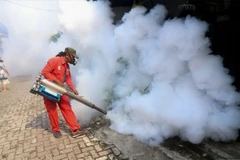 The Building Resilience Drought Southeast Asia dialogue held in Can Tho city on December 10 (Photo: VNA)
The Building Resilience Drought Southeast Asia dialogue held in Can Tho city on December 10 (Photo: VNA) Can Tho (VNS/VNA) - ASEAN-member countries have vowed to takeimmediate action to resolve problems caused by worsening drought in SoutheastAsia, especially in Vietnam’s Mekong Delta region, which is especiallysusceptible to global warming.
Speaking at a meeting on December 10 in Can Tho, Intani Nur Kusuma, seniorofficer at the Disaster Management and Humanitarian Assistance Division of theASEAN Secretariat, said that a declaration on drought would be adopted byleaders at the ASEAN Summit to be held in Vietnam in November next year.
ASEAN has worked closely with relevant sectors to help the ASEAN Committee onDisaster Management draft the declaration, she said, adding thatdrought-related activities need to be integrated into the future action plan ofASEAN.
To mitigate the impact, drought risk assessment and early-warning servicesshould be improved through the sharing of data from space-based technologies.
Risk-financing instruments as well as improvement of people’s awareness of theeffects of drought are also needed.
Tiziana Bonapace, director of the Information and Communications Technology andDisaster Risk Reduction Division of the Economic and Social Commission for Asiaand the Pacific (ESACP), told Vietnam News: “Climate change has alreadyhappened. Now is the time to adapt instead of fighting it.”
“Southeast Asia is faced with intensification and a changing geography ofdrought, and of disaster risk in general, as climate change converges withsocial, environmental and economic stresses.
“Regional cooperation, especially among nations benefiting from the MekongRiver, is needed to support national efforts to manage drought through data,technology, innovations, policy and financing options,” Bonapace said.
“The best solution is no single solution but a multi-approach solution,” sheadded. “Negotiations and dialogue are also needed among all the countriesinvolved based on science and technology and evidence.”
“Our new analysis shows disasters in the region are having more impact thanpreviously thought. Much of the increase is due to the quantification ofagricultural drought losses, which was not reported before,” she noted.
Nguyen Truong Son, deputy head of the Vietnam Disaster Management Authority,said the Mekong Delta and Central Highlands regions were facing abnormalweather that could be attributed to climate change.
The Mekong River levels in June and July significantly fell compared toprevious years, raising concern of exacerbated drought and saline intrusion forthe entire Mekong Delta in the 2019-20 dry season.
In the Central Highlands, rainfall in the dry season has dropped considerablycompared to previous years, while temperatures have been 0.5-1 degrees Celsiushigher than average, sparking serious droughts that have threatened vast tractsof natural forests as well as crops.
No Southeast Asian country can afford to ignore drought when trying to mitigatethe economic impact of natural disasters, according to experts.
Bonapace said the significance of economic losses due to agricultural droughtwas consistent across all countries for which data is available.
“The agricultural losses are highest in Indonesia. In Vietnam, we estimate itto be around 6.5 billion USD or 3 percent of GDP,” she said.
Disasters continue to erode economic gains. Ultimately this means thatdisasters will limit the ability of economic growth to eradicate poverty.
“According to our study, the economic models show that without disasters, Vietnamis expected to completely eradicate extreme poverty by 2030,” Bonapace said.
According to the Asia-Pacific Disaster Report 2019, annual economic losses inAsia Pacific more than quadruple when slow-onset disasters, most notablydrought, are added to the region’s disaster risk landscape.
The average annual loss for the region is 675 billion USD, of which 405 billionUSD, or 60 percent, is drought-related agricultural losses.
In Southeast Asia, the average annual loss is higher than the Asia-Pacificregional average, reaching 86.5 billion USD or 3 percent of the regional GDP.
The average annual loss is highest in Cambodia, Myanmar, Laos, Vietnam, and thePhilippines.
According to the 2019 Report Ready for the Dry Years report, though startingslowly, drought can have a devastating cumulative impact, striking hardest atthe poor and heightening inequality and degrading land, all of which increasesthe prospects of conflict.
According to the report, there will be many more dry years ahead, and the areaaffected by drought is likely to shift and expand.
The report was jointly produced by ESCAP and ASEAN as part of theirdisaster-risk reduction efforts.
Experts have recently expressed concern about a number of dams impeding theMekong Delta’s flow, drying up many parts of the once fast-flowing river andleaving the region facing serious drought.
Le Cong Thanh, deputy minister of the Ministry of Natural Resources andEnvironment, said an increasing number of dam constructions in the Mekong Riverwere “posing a great burden on the 4,700-kilometre Mekong River basin,especially on the Mekong Delta”.
As a result, millions of people who depend on the river for their livelihoodsin Vietnam, China, Laos, Myanmar and Thailand will be seriously affected.
The Mekong River Commission, a regional intergovernmental agency that managesthe river’s water resources, said that all the “dams in the upstream Mekong Rivercountries contribute to worsening drought in the region”.
The river’s water levels last month recorded their lowest level in 60 years.Other estimates suggest that water levels have dropped to their lowest level ina century, the commission said.
Lower freshwater river levels mean that saltwater levels in the delta couldrise, threatening rice-growing and agriculture in general, while agricultureirrigated by the river could suffer if nutrient-rich sediment is blocked fromflowing downriver by dams.
The Mekong River, which originates in China and snakes through five SoutheastAsian countries, is emerging as a new security flashpoint, experts have warned.
The river begins in the Tibetan Plateau, stretches through much of mainlandSoutheast Asia, and ends in the Mekong Delta.
The one-day Building Resilience Drought Southeast Asia dialogue wasco-organised by the Vietnam Disaster Management Authority, ESCAP, and the ASEANSecretariat./.
VNA





























